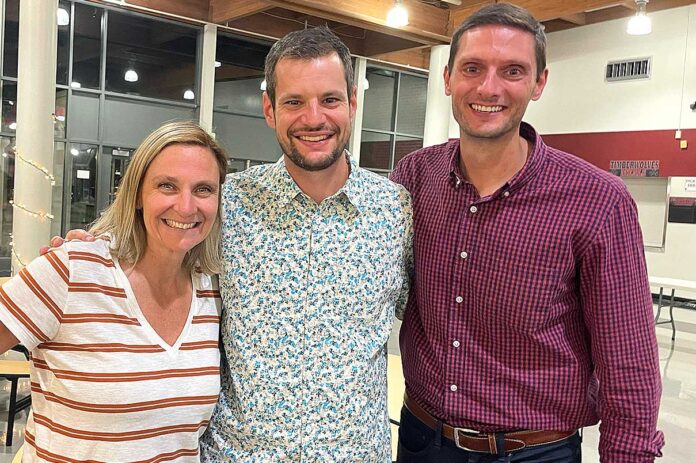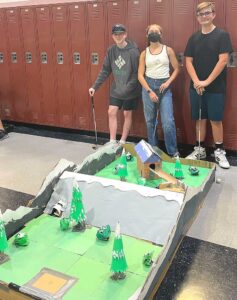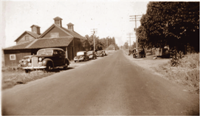
The school year began with a twist for Tualatin High School students taking part in an innovative pilot program that will lead them out of the classroom and into the community to solve real-world problems.

Design Core teams 80 randomly selected first-year students who’ll learn biology, language arts, and social studies through the lens of humanity’s most basic needs: food and water, using a problem-solving method called “design thinking” that emphasizes human connection, creativity, and empathy.
Throughout the year, they’ll be charged with collectively identifying real-world problems and then collaborate on devising innovative solutions.
Students are given agency over their education by helping determine the direction of projects while teachers guide them, emphasizing skills like peer feedback. Grades are deemphasized but not discarded, and imperfection is valued.
“They’ll do tons of creative ideation and barnstorming and build a prototype, build a model, and test it,” said social studies teacher Andrew Bonica, who conceived the program and teamed with two colleagues to bring it to life. “As a teacher, I use this process every time I design a lesson.”
Bonica is leading the social studies component, with Becky Beeler covering language arts and Daniel Rott focusing on biology.
“We’re very excited. Some of the best ideas in education come from teachers wanting to make the experience authentic,” said Principal Michael Dellerba, who praised his teachers’ creativity, flexibility, and willingness to venture into the unknown. “When you talk to people from industry (design thinking is) what they are looking for,” said Dellerba.
For their first challenge, students zeroed in on the question, “How might we design a creative, original, cheap, and FUN mini-golf course,” then set about answering it in small groups that were each given 6-hours to design a hole.
Parents were invited to play the 18-hole course during a Design Core family night.
“We combined all of our ideas,” said Freshman Mariah Aguilar of the hole she and three teammates created.
“We worked out a few designs on paper, trying to see which would work best, and then we had to modify it for our supplies.”
“Trial and error,” her teammate Stephen Pettitt added.
That’s exactly what teachers were hoping to get from this warm-up project, meant to build skills for tackling bigger challenges as the year progresses.
Down the line, the group will identify an immediate societal problem related to food – and then water next semester – and collaborate to devise a solution.
Each teacher will explore the themes in their own subjects to give students the depth of understanding they’ll need when they convene to find their question.
In Bonica’s class, they’re starting with Michael Pollen’s deep dive into food, The Omnivore’s Dilemma.
“Food is a bonding agent. We’re going to be asking students to learn a lot about food,” he said. “The culture, immigration, and where our food comes from. Telling stories, creating their own meals and experiences, and sharing it with friends and family.”
In Rott’s biology class, they’ll dig into the science of food.
This integrated process over product approach values risk-taking and testing ideas as a means to mastery.
“I’m thrilled with how engaged the students are,” Beeler said. “Seeing them take risks and asking for more and more feedback is just something I haven’t seen in my 25-year career. It’s very cool.”
Logistically, it works like this: Core students attend each subject during the first three periods, every other school day, creating a chunk of time where Bonica, Rott, and Beeler can sometimes work with the whole group together at school or take time them out into the community for fieldwork.
Who, what, when, where, and how are all questions to be uncovered along the way.
It’s a journey of discovery.
“One of the cool things is within that project, we really don’t know what the end results are going to be,” Bonica said. “We have general parameters. We’re going to be asking the students questions like ‘how might we design sustainable solutions for food availability that is rooted in cultural significance and identity?”
Design thinking will have them break the creative process down into smaller components, beginning with empathy and understanding of a problem.
The program and approach are predicated on making students partners in their education.
“We want the students to have the freedom to be able to think about how they want to make it happen and give them a structure where they’re still going to be hitting standards and learning traditional academic skills,” Bonica said. “And, at the same time, have something physical to give to other people (at the end of the semester) and show their knowledge in a way that’s hopefully really putting them in the spotlight in a positive way, trying to give them agency and autonomy in their learning.”



















